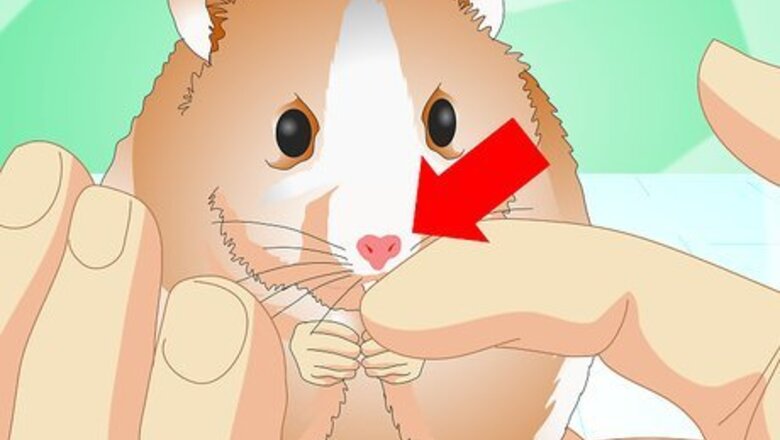
views
Doing Daily Checks
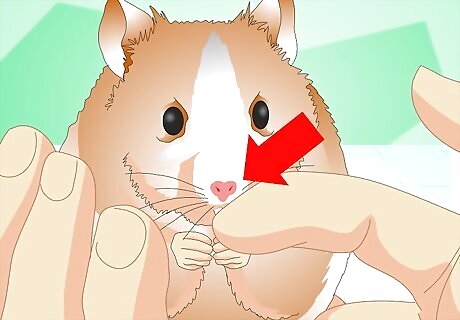
Check your hamster's nose. A hamster's environment can cause your hamster to develop a cold or breathing problem. Therefore, to make sure the temperature is appropriate, you should check your hamster's nose weekly to gauge his health. Does your hamster's nose seem abnormally wet? Is there any discharge coming from his nose? If not, your hamster is probably in good health. If your hamster's nose is runny and wet, he may have a cold. Hamsters catch colds fairly easily and they usually go away on their own. Just give you hamster space to rest until symptoms clear up. If his nose is running for more than a week, he may be allergic to something in his cage. Try removing any new toys or bedding and see if symptoms clear up.
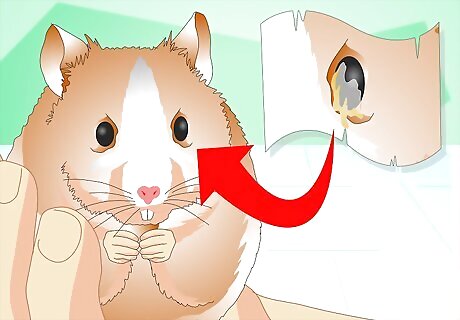
Watch your hamster's eyes. Hamsters are prone to eye troubles. Eye infections and chronic conditions like glaucoma can cause cloudy eyes, discharge, and difficulty seeing. Check your hamster's eyes daily. As eye infections and chronic conditions require specific medications, you should have any unusual changes evaluated by your veterinarian. He or she can help you form a health plan for your hamster. Hamster eyes should be clean and clear. They should be free of discharge and any tears in the corners of the eyes. In the event of an infection, a hamster's eyelids may swell and become droopy.
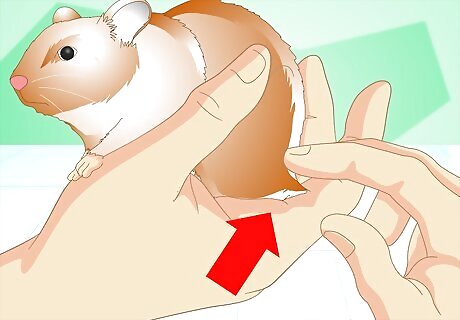
Look at your hamster's bottom. A hamster's rear end should be clean and clear of any fecal matter or unusual discharge. Conditions like chronic constipation, issues with the stomach, and reproductive problems can often be detected by examining a hamster's rear end. You should check you hamster's rear on a daily basis to watch for warning signs. Staining or loose droppings may indicate a hamster has diarrhea or is having difficult passing stools. This could be a minor issue, like the food you're feeding your hamster, or it could be a sign of an underlying medical condition. Take your hamster to your vet if you notice staining or droppings on a hamster's bottom. A wet tail may also be a sign of diarrhea. As stress can be a cause of diarrhea, any recent changes to a hamster's environment may trigger such health problems. If you moved to a new apartment, for example, your hamster may have an upset stomach for a few days. Give your hamster a few days to adjust and see if symptoms clear up. If they do not, contact your vet. An infection of the womb in female hamsters, known as Pyometra, can be detected by examining a hamster's bottom. If you notice discharge from the opening above your hamster's anus, it may be a sign of infection. The discharge may produce a pungent odor. As Pyometra can be serious if untreated, get your hamster to the vet immediately if you notice these symptoms.
Checking Your Hamster Weekly
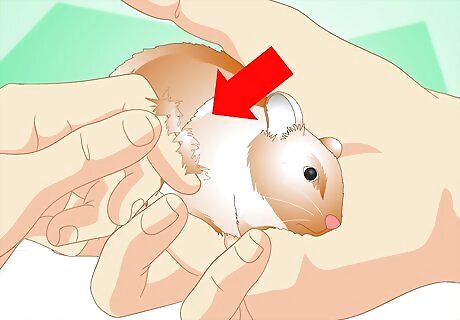
Examine your hamster's skin and hair. A hamster's fur and skin should be monitored for changes weekly. Some changes are normal. Older hamsters, for example, are prone to thinning hair. However, hair loss in a younger hamster may be a sign of health problem and should be evaluated by a vet. Hamster's fur and skin varies by breed. You should know your hamster's normal coat condition and be able to tell if it is changing. A deteriorating coat on an older hamster is normal. However, in a younger hamster dry fur, matted patches of hair, skin rashes, flaky skin, and bald spots can be a warning sign. Fur loss and skin rashes can be a sign of an easily treatable problem, like fleas or mites. However, they can also be a sign of a chronic condition like Cushing's disease. It's important to have your hamster evaluated by a vet in the event of skin and fur changes to diagnose the issue properly. If mites, fleas, and chronic diseases are ruled out by a vet, your hamster may be allergic to his bedding or toys. Try removing certain items, like any new toys or chews, from his cage or changing the bedding. If you notice an improvement when a certain material is removed, your hamster's fur changes were likely an allergic reaction.
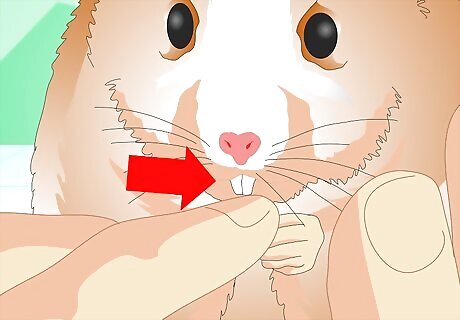
Look at your hamster's teeth. Hamsters are prone to overgrown and uneven teeth. You may need to occasionally take your hamster to the vet to have this teeth trimmed. You should also monitor the color of his teeth to make sure they're healthy. A hamster's teeth should be of more or less the same length. The bottom teeth should be longer than the top teeth. If your hamster's teeth seem to be getting longer, try providing him toys he can chew on. This can help keep his teeth at an appropriate height. You can buy traditional wooden chews made specifically for hamsters or purchase dog biscuits for your hamster. A hamster's teeth should be yellow. If you notice your hamster's teeth whitening, take him to a vet to check for signs of a mouth infection. On occasion, you may need to have your vet trim your hamster's teeth. If your hamster's teeth begin curving inwards towards his mouth and jaw, take him to the vet. A qualified veterinarian can clip your hamster's teeth safely. Your vet may also provide you with instructions on how to trim your hamster's teeth on your own.
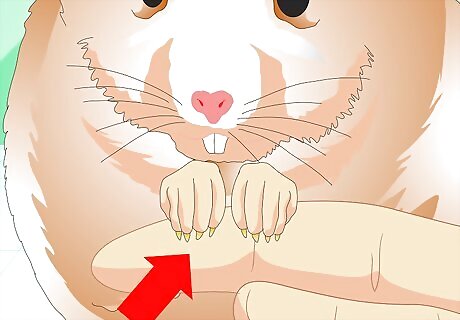
Inspect your hamster's nails. Much like teeth, hamster nails can become overgrown. You can provide a hamster with longer nails with a big of store bought hamster sand. The hamster will dig in the sand and wear down his nails to an appropriate level. Check your hamster's nails each week. If they seem to be growing longer and curving downward, pick up some sand for your hamster at a local pet shop. Not all hamsters take well to sand. Some hamsters dislike playing in the sand. Other hamsters have very strong nails that do not wear down with digging. If your hamster's nails do not seem to improve with sand, make an appointment with your vet to have them trimmed.
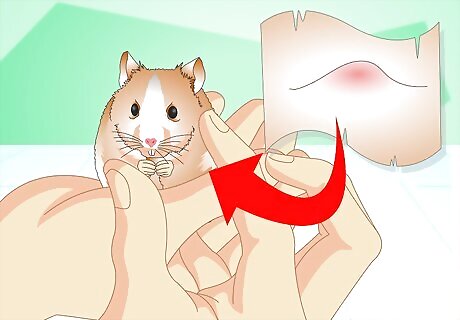
Watch for lumps. Hamsters can get benign and cancerous growths on all parts of their bodies. Such growths should be evaluated by a veterinarian as soon as possible to decide on a course of treatment. Once a week, take your hamster out of his cage and gently inspect him for lumps. Allow your hamster to come to you. Put your hand in the cage, palm upward, and wait for him to come sniff you before picking him up or handling him. Handle your hamster gently as not to cause him pain. Examine all over your hamster's body for any new lumps or bumps. If you find a bump on your hamster, don't panic. Hamsters are prone to benign cysts and ulcers. However, if the lump is cancerous early intervention is key. Removing a cancerous lump in its early stages improves your hamster's chance at recovery. Stay calm and make an appointment with your vet for evaluation as soon as possible. Hamsters have scent glands near their hips. People often mistake these for cuts or lumps, but they are a perfectly normal part of a hamster's anatomy. However, if a hamster is vigorously licking at his scent glands he may dislike the smell of something in his cage. Consider removing any new toys or bedding and see if the behavior stops.
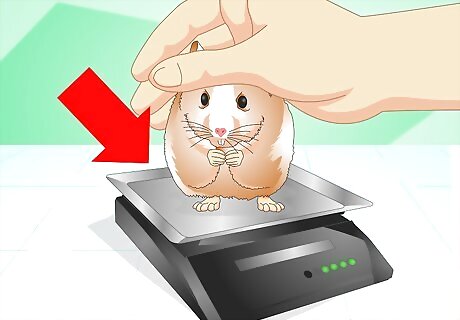
Weigh your hamster. The appropriate weight of a hamster varies by breed but your hamster's weight should stay relatively stable. It may fluctuate by a few grams each week, but any major changes could be a sign of a health condition. You can weigh a hamster on a small handheld scale you might use in the kitchen to weigh food. It's normal for a hamster's weight to increase until he's six months or older. However, a full grown hamster's weight should not continue growing each week. If your hamster's weight is increasing, talk to your vet about adjusting his feeding schedule. Obesity can cause a number of health conditions in your hamster. As in humans, weight loss and loss of appetite is a sign of a variety of health problems. If your hamster is losing weight each week, take him to a vet for evaluation.
Recognizing Signs of Poor Health
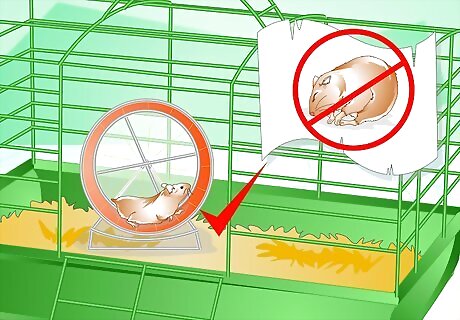
Recognize healthy behavior. In order to recognize warning signs, understand what's normal. Your hamster should be fairly energetic and social. Hamsters move around in their cage frequently and like to chew on wood chips and toys. Hamsters are naturally nocturnal, but tend to adapt to your schedule with time. If you've had your hamster for a while, you can expect to see him awake when you're awake. A hamster's breathing patterns should be even and clear. If your hamster seem lethargic, sleeps a lot, or if his breathing sounds labored you should take him to a vet.
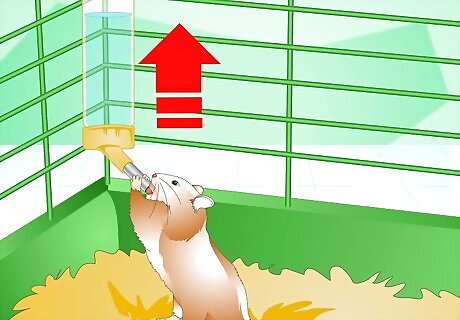
Keep an eye on water consumption. Hamsters can develop diabetes. Increased water consumption is a common early sign. Keep an eye on how much your hamster is drinking and, if he seems to be consuming more water than usual, take him in for a check up. Hamsters drink different levels of water depending on size and breed. However, try to keep track of how much you refill a hamster's water bowl on an average day or week. If you suddenly seem to be refilling the bowl more, you should have your hamster tested for diabetes. There is no cure for diabetes in hamsters. However, changes to a hamster's diet can help improve symptoms. If your hamster does have diabetes, you should go over a treatment plan with your veterinarian.
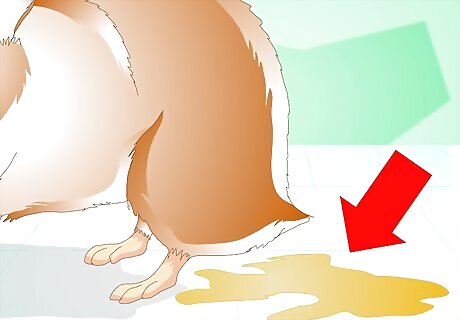
Monitor urine color. Hamster's urine should be clear or yellow. If you notice brown or reddish urine, this could be a sign of a variety of problems. It may be something benign, like an effect of the pellets you're using. However, your hamster could also have a urinary infection or bladder stones. Red urine should be evaluated by a veterinarian as soon as possible.
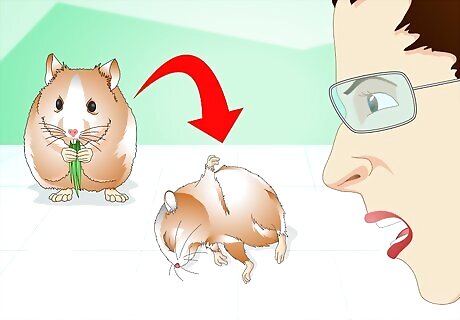
Be wary of changes in movement. Older hamsters sometimes suffer strokes. However, strokes can happen at any age. They usually occur at night and your hamster may be still and have trouble walking and running when in the morning. Other sudden changes in movement could indicate other health problems. If your hamster is having trouble eating or drinking, he may have suffered a stroke or have another health condition that affects his movement. Have him evaluated by a veterinarian. In rare cases, a hamster might suffer chronic seizures. Your hamster might move his arms and legs uncontrollably while his mouth is opened. He will stare blankly with his eyes looking dull and unfocused. Seizures are a hereditary condition for which there is no cure. However, you can adjust your hamster's cage, food, and water for his safety and comfort. Hamsters who have seizures can live relatively normal life spans.

















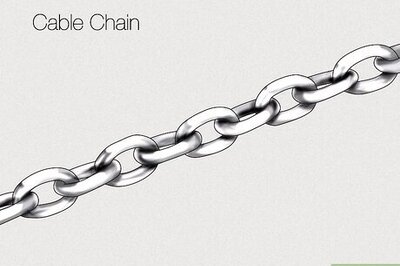


Comments
0 comment